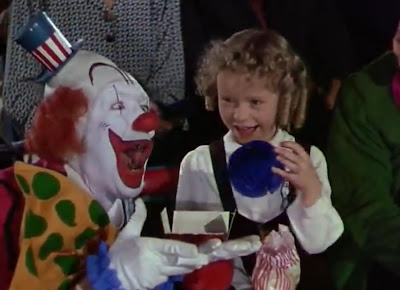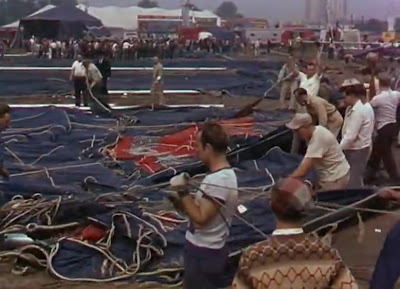 |
| Rival trapeze artists (Betty Hutton, Cornel Wilde) compete to be the top act, flirting all the while. |
Release Date: Jan. 10, 1952. Running Time: 152 minutes. Screenplay: Fredric M. Frank, Theodore St. John, Barré Lyndon. Producer: Cecil B. DeMille. Director: Cecil B. DeMille.
THE PLOT:
The board of directors of the Ringling Brothers and Barnum & Bailey Circus wants to protect profits by running a meager 10-week season, playing only the big cities. General manager Brad Braden (Charlton Heston) disagrees, and he manages to sway the board with two conditions: First, that the circus will complete the full season only if it manages to stay in the black; and second, that he will bring in a star act to draw the crowds.
That star is "The Great Sebastian" (Cornel Wilde), a trapeze artist who is incredible in the air... and incredibly difficult on the ground. A serial womanizer, Sebastian has two former lovers already with this circus. He quickly sets his sights on a new target: Holly (Betty Hutton), an aerialist whose act his arrival pushed from the top spot at center ring.
Holly resents the demotion. She resolves to get her spot back, vowing that she'll make sure the public's eyes are on her instead of Sebastian. This leads to a direct and public competition, with the two engaging in increasingly spectacular and dangerous stunts. Brad initially goes along with it, as the rivalry proves to be a boon for ticket sales - but as the contest goes on, he begins to worry that it might end in tragedy!
 |
| Holly is torn between fellow aerialist Sebastian and circus manager Brad (Charlton Heston). |
CHARACTERS:
Holly: Betty Hutton spent six months training for her role, enabling her to do many of her own stunts. This pays off in the Big Top set pieces, as she swings upside down on the trapeze in one scene and performs flips on it in another. As the story opens, she's in a relationship with Brad that's a little too unspoken. Everyone in the circus agrees that they're a couple, but she is frustrated at the thought that he cares more about the business than her - making her extremely vulnerable to the charms of Sebastian, a fellow aerialist who understands exactly what it's like in the air and how much it means to her.
Sebastian: Director Cecil B. DeMille originally wanted Burt Lancaster (an actor with an actual circus background) to play Sebastian. After Lancaster passed, the role eventually went to Cornel Wilde... which I think is for the best, as Wilde's screen presence is a much better fit for the egotistical, womanizing showman. He's the last of the principles to make his entrance, arriving just as the circus is getting ready to depart - speeding in a sports car, with police sirens in his wake and a $100 traffic ticket (in early 1950s money) passed directly to circus billing on his behalf.
Sebastian's womanizing past leaves the viewer uncertain whether his amorous pursuit of Holly is serious. On the one hand, he stands up for her to Brad when he has the clowns comically pull her down from a dangerous stunt, fully comprehending her feelings in a way that Brad simply can't; on the other, their first romantic scene together consists of him using lines that she later learns were recycled from previous conquests. One thing he's serious about, however, is besting Holly's challenge, with him refusing to drop the rivalry even when Brad insists on it.
Brad: Though he's only third billed, Charlton Heston's Brad is very much the film's anchor. The opening scenes that establish the circus life follow him as he moves from one act or animal to the next, solving problems with practically every breath. He's honest and tough, but he's much better at dealing with logistics than with emotion. His inability to actually tell Holly how he feels about her threatens their relationship, with her being drawn more and more to Sebastian. He can see this, but he can't seem to make himself say the words or take the actions that will hold her - even though he consistently acts quickly and decisively in matters of circus logistics. This was Heston's breakthrough role, and the earnest, tough-as-nails Brad could more or less be considered the template for much of the career that followed.
Buttons the Clown: The head clown, who is never seen without his makeup and who is tight-lipped about his past. James Stewart plays the entire role in clownface. Remarkably, this doesn't hamper his performance at all. We see immediately, as he deals with an upset Holly, that he is compassionate and perceptive. He shows loyalty to her and Brad on multiple occasions, but he gives only the scantest of hints about his life before the circus. Eventually, we learn that he's on the run from police, though this subplot remains in the background until the final Act.
 |
| Buttons (James Stewart), the clown with a mysterious past, is easily the most interesting character in the movie. |
THOUGHTS:
Though he's best remembered for his Biblical epics, producer/director Cecil B. DeMille was nothing if not a showman, which made a film about the circus a natural fit. In a way, this movie is a snapshot of the last moments of the old-style circus. The film opens with execs arguing to cut back, tour less, and stick to the big cities. Just a few years later, Ringling Brothers and Barnum and Bailey would do exactly that, restricting performances to air-conditioned venues (which, in the 1950s, pretty much meant big cities). In essence, DeMille is chronicling a way of life that was already about to change, making it almost a nostalgia piece even though it was set in the (then) present day.
The Greatest Show on Earth is by no means a great movie. The story consists of soap opera antics that were hackneyed when it was released, and the characters are shallow. Still, it is entertaining, and the set pieces hold up well.
The circus performances are interesting in how they are shot. When the focus is on the characters, DeMille goes close-up so that we share the emotion and feel the sense of danger. This is particularly true when Holly and Sebastian are competing, though it's also seen during an elephant act in which a jealous trainer (Lyle Bettger) uses the animal and his control over it as a threat to a performer (Gloria Grahame) who doesn't return his affections. When we're meant to feel the drama, DeMille goes in close.
The rest of the time, we're put in the bleachers with the audience. We view the performances from a particularly good seat, but we still see the action from a distance, over the heads of other spectators seated in front of us. DeMille wants the viewer to feel like a circus spectator as he documents the spectacle, and this works quite well.
The movie has its faults, the biggest of which is that it's overlong. The moments showing the rivalry between Sebastian and Holly are strong, but the other circus acts are allowed to run on and on. About 45 minutes in, there's a parade around the Big Top featuring popular characters of the day. This goes on for a good seven minutes, with the parade only briefly broken up by about thirty seconds of story material involving James Stewart's fugitive clown. If the scene was cut in half, it wouldn't hurt the spectacle; it would just help the pacing.
Padding isn't restricted to set pieces. The love triangle between Brad, Holly, and Sebastian isn't particularly complex, and the scenes portraying it become repetitive. Holly tries to get Brad to commit emotionally; he ignores her; she and Sebastian flirt. Reheat and reapply as necessary. In addition, there are two supporting female characters, Phyllis (Dorothy Lamour) and Angel (Gloria Grahame), both of whom were previously involved with Sebastian. Their roles are so similar that I often became confused about which was which. Had they been combined into a single person, the film would have lost nothing but a few minutes of extra running time.
Finally, there are a few bizarre technical flaws. Not in the scenes where you'd expect a 1950s film to feature bad edits or obvious greenscreen - as noted, the set pieces look great - but rather in scenes that seem less complicated. An early exposition scene with a low-level gangster (Lawrence Tierney) and his henchman features a horribly jagged cut, despite it being a fairly short conversation that could have played out in a single take. A late parade through a small town features some appalling greenscreen, even though a film of this budget surely had no need to do any of that sequence in studio. These moments stand out all the more given how good everything around them looks.
 |
| Workers stretch out the canvas of the Big Top before raising it at their latest location. |
OSCAR CONTROVERSY:
The Greatest Show on Earth is often regarded as one of the worst Best Picture winners. Its primary competitor at the Oscars was High Noon, which is widely agreed to be the better movie, and which is often seen as an allegory about the Hollywood blacklist. This has led some to speculate that the award had less to do with quality than with politics.
This is a complex topic, and I don't want to deviate from the focus on The Greatest Show on Earth as a movie, so I'll examine it in a supplemental post. Suffice it to say: I agree that Greatest Show didn't deserve to win, but I wouldn't rank it as anywhere near the worst Best Picture winner. It may occupy shallow waters, and it's probably a good twenty minutes too long... but it is enjoyable, even today, which puts it far above a few other winners that I can think of.
REMAKES AND RETELLINGS:
The Greatest Show on Earth was rebooted as a television series by Desilu Productions, running for thirty episodes from 1963 to 1964 and starring Jack Palance in the Charlton Heston role. Like the movie, it was made with the assistance of the Ringling Brothers and Barnum and Bailey Circus. It featured big name guest stars including the movie's Betty Hutton and also Don Ameche, Lucille Ball, James Coburn, Buster Keaton, and many, many others. But facing stiff competition from CBS comedies and NBC celebrity talk shows, it just couldn't justify its own expense and was canceled after a single season.
Anecdotally, director Steven Spielberg has credited the movie and specifically its train derailment sequence for igniting his passion for filmmaking. This was dramatized in Spielberg's recent autobiographical film, The Fabelmans.
 |
| A train derailment forms the movie's Third Act crisis, bringing the various subplots to a head. |
OVERALL:
It's big. It's corny. It's overlong. It has all the depth of a puddle. I really can't argue with the most common criticisms levied against The Greatest Show on Earth.
For all of that, I found it entertaining. It didn't deserve the win. It probably didn't even deserve the nomination. But taken on its own terms, it's a good example of classic Hollywood hokum. The actors are likable, the set pieces hold up well, and the spectacle is well-shot (even if some other moments bizarrely aren't).
I wouldn't necessarily call it "good." But I enjoyed watching it - and with this type of film, what more can one really ask?
Overall Rating: 7/10.
Related Post: The Greatest Show on Earth versus High Noon - Politics, Popularity, and the Academy Award for Best Motion Picture of 1952.
Best Motion Picture - 1951: An American in Paris
Best Motion Picture - 1953: From Here to Eternity
Review Index
To receive new review updates, follow me:
On BlueSky:
On Threads:


No comments:
Post a Comment